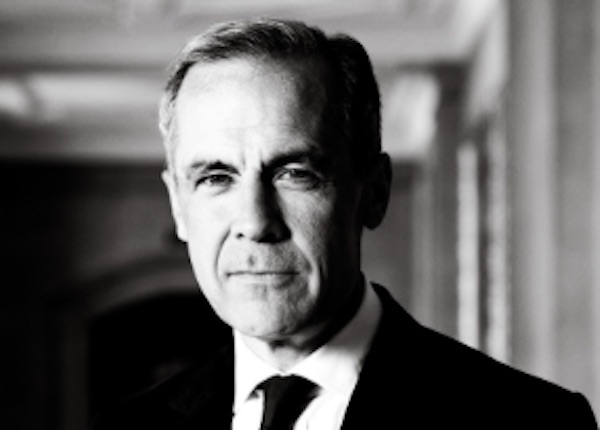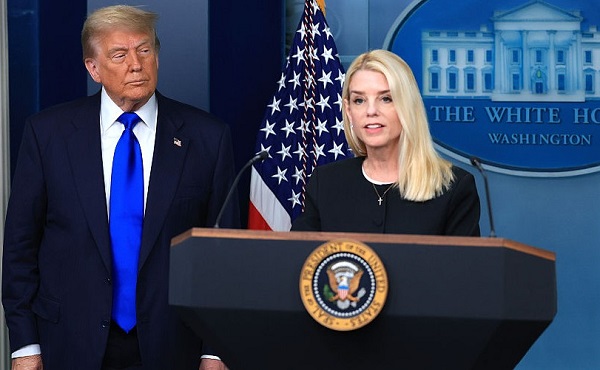Energy
The Real Threat to Banks Isn’t From Climate Change. It’s From Bankers.

Over the last two years, some of the world’s most powerful and influential bankers and investors have argued that climate change poses a grave threat to financial markets and that nations must switch urgently from using fossil fuels to using renewables.
In 2019, the Federal Reserve Bank of San Francisco warned that climate change could cause banks to stop lending, towns to lose tax revenue, and home values to decline. Last year, 36 pension fund managers representing $1 trillion in assets said climate change “poses a systemic threat to financial markets and the real economy.”
And upon taking office, President Joe Biden warned government agencies that climate change disasters threatened retirement funds, home prices, and the very stability of the financial system.
But a major new staff report from the New York Federal Reserve Bank throws cold water on the over-heated rhetoric coming from activist investors, bankers, and politicians. “How Bad Are Weather Disasters for Banks?” asks the title of the report by three economists. “Not very,” they answer in the first sentence of the abstract.
The reason is because “weather disasters over the last quarter century had insignificant or small effects on U.S. banks’ performance.” The study looked at FEMA-level disasters between 1995 and 2018, at county-level property damage estimates, and the impact on banking revenue.
The New York Fed’s authors only looked at how banks have dealt with disasters in the past, and what they wrote isn’t likely to be the final word on the matter. The United Nations Intergovernmental Panel on Climate Change and most other scientific bodies predict that many weather events, including hurricanes and floods, which cause the greatest financial damage, are likely to become more extreme in the future, due to climate change.
And in February, The New York Times quoted one of six United States Federal Reserve governors saying, “Financial institutions that do not put in place frameworks to measure, monitor and manage climate-related risks could face outsized losses on climate-sensitive assets caused by environmental shifts.”
But the Fed economists looked separately at the most extreme 10 percent of all disasters and found that banks impacted not only didn’t suffer, “their income increases significantly with exposure,” and that the improved financial performance of banks hit by disasters wasn’t explained by increased federal disaster (FEMA) aid.
In other words, disasters are actually good for banks, since they increase demand for loans. The larger a bank’s exposure to natural disasters, the larger its profits.
Happily, the profits made by banks are trivial compared to rising societal resilience to disasters, which can be seen by the fact that the share of GDP spent on natural disasters has actually declined over the last 30 years.
While scientists expect hurricanes to become five percent more extreme they also expect them to become 25 percent less frequent, and now, new data showglobal carbon emissions actually declined over the last decade, and thus there is no longer any serious risk of a significant rise in global temperatures.
Banking Against Growth
Biden nominee Saule Omarova said she wants to bankrupt energy companies
The real risk to banks and the global economy comes from climate policy, not climate change, particularly efforts to make energy more expensive and less reliable through the greater use of renewables, new taxes, and new regulations.
“For policymakers,” warned the three economists writing for the New York Fed, “our findings suggest that potential transition risks from climate change warrant more attention than physical disaster risks.”
While they may seem like outliers, they are far from alone in expressing their concern. The second half of the quote by the Fed governor about climate change, which was hyped by The New York Times, warned that banks “could face outsized losses” from the “transition to a low-carbon economy.” (My emphasis.)
And, now concern is growing among members of Congress about the dangers of over-relying on weather-dependent energy, with some members citing the New York Fed’s report after The Wall Street Journal editorialized about it last week .
Proof of the threat to the economy from climate policy is the worst global energy crisis in 50 years. Shareholder activists played a significant role in creating it, according to analysts at Goldman Sachs, Bloomberg, and The Financial Times, by reducing investment in oil and gas production, and causing nations to over-invest in unreliable solar and wind energies, which has driven up energy prices, and contributed significantly to inflation.
And yet a crucial Biden Administration nominee for bank regulation has openly said she would like to bankrupt firms that produce oil and gas, the two fuels whose scarcity is causing the global energy crisis. Progressive academic, Saule Omarova, nominated by Biden, said recently that “we want [oil and gas firms] to go bankrupt” and that “the way we basically get rid of these carbon financiers is we starve them of their source of capital.
Omarova is not an outlier. The Biden Administration’s Financial Stability Oversight Council (FSOC) is advocating 30 new climate regulations that should be imposed on banking. Many analysts believe the US Securities and Exchange Commission will require new regulations. The goal is to radically alter how America’s banks lend money, the energy sector, and the economy as a whole.
And former Bank of England chief, Mark Carney, co-chair of the Glasgow Financial Alliance for Net Zero, has organized $130 trillion in investment and said recently that his investors should expect to make higher, not lower, returns than the market. How? In the exact same way Omarova predicted: by bankrupting some companies, and financing other ones, through government regulations and subsidies.
Carney created the Glasgow Financial Alliance, or GFANZ, with Michael Bloomberg, and they did so under the official seal of the United Nations. “Carney said the alliance will put global finance on a trajectory that ultimately leaves high-carbon assets facing a much bleaker future,” wrote a reporter with Bloomberg. “He also said investors in such products will see the value of their holdings sink.”
What’s going on, exactly? How is it that some of the world’s most powerful bankers, and the politicians they finance, came to support policies that threaten the stability of electrical grids, energy supplies, and thus the global economy itself?
Donate to Environmental Progress
The Unseen Order
Tom Steyer, Michael Bloomberg, and George Soros
Three of the largest donors to climate change causes are billionaire financial titans Michael Bloomberg, George Soros, and Tom Steyer, all of whom have significant investments in both renewables and fossil fuels.
Soros is worth $8 billion and recently made large investments in natural gas firms (EQT) and electric vehicles (Fisker), Bloomberg has a net worth of around $70 billion and has large investments in natural gas and renewables, and much of Steyer’s wealth derives from investments in all three main fossil fuels—coal, oil, and natural gas — as well as renewables.
All three men finance climate activists and politicians, including President Biden, who then seek policies — from $500 billion for renewables and electric vehicles over the next decade to federal control over state energy systems to banking regulations to bankrupt oil and gas companies — which would benefit each of them personally.
Bloomberg gave over $100 million to Sierra Club to lobby to shut down coal plants after he had taken a large stake in its replacement, natural gas, and operates one of the largest news media companies in the world, which publishes articles and sends emails nearly every day reporting that climate change threatens the economy, and that solar panels and wind turbines are the only cost-effective solution.
Soros donates heavily to Center for American Progress, whose founder, John Podesta, was chief of staff to Bill Clinton, campaign chairman for Hillary Clinton’s presidential campaign, and who currently runs policy at the Biden White House. So too does Steyer, who funds the climate activist organization founded by New Yorker author Bill McKibben, 350.org, which reported revenues of nearly $20 million in 2018.
The most influential environmental organization among Democrats and the Biden Administration is the Natural Resources Defense Council, NRDC, which advocated for federal control of state energy markets, the $500 billion for electric cars and renewables, and international carbon markets that would be controlled by the bankers and financiers who also donate to it.
In the 1990s, NRDC helped energy trading company Enron to distribute hundreds of thousands of dollars to environmental groups. “On environmental stewardship, our experience is that you can trust Enron,” said NRDC’s Ralph Cavanagh in 1997, even though Enron executives at the time were defrauding investors of billions of dollars in an epic criminal conspiracy, which in 2001 bankrupted the company.
From 2009 to 2011, NRDC advocated for and helped write complex cap-and-trade climate legislation that would have created and allowed some of their donors to take advantage of a carbon-trading market worth upwards of $1 trillion.
NRDC created and invested $66 million of its own money in a BlackRock stock fund that invested heavily in natural gas companies, and in 2014 disclosed that it had millions invested in renewable funds.
Former NRDC head, Gina McCarthey, now heads up Biden’s climate policy team, and Biden’s top economic advisor, Brian Deese, last worked at BlackRock, and almost certainly will return at the end of the Biden Administration.
Money buys influence. In 2019, McKibben called Steyer a “climate champ” when Steyer announced he was running for president, adding that Steyer’s “just-released climate policy is damned good!” And in 2020, McKibben wrote an article called, “How Banks Could Bail Us Out of the Climate Crisis,” for The New Yorker, which repeated the claim that extreme weather created by climate change threatens financial interests, and that the way to prevent it is to divert public and private money away from reliable energy sources toward weather-dependent ones.
Forms filed to the Internal Revenue Service by Steyer’s philanthropic organization, the TomKat Charitable Trust, show that it gave McKibben’s climate activist group, 350.org, $250,000 in 2012, 2014, and 2015, and may have given money to 350.org in 2013, 2016, 2017, 2018, 2019, and 2020, as well, because 350.org thanked either Steyer’s philanthropy, TomKat Foundation, or his organization, NextGen America, in each of its annual reports since 2013.
At the same time, McKibben’s motivations are plainly spiritual. He claims that various natural disasters are caused by humans, that climate change literally threatens life on Earth, and is thus “greatest challenge humans have ever faced,” a statement so unhinged from reality, considering declining deaths from disasters, declining carbon emissions, and the total absence of any science for such a claim, that it must be considered religious.
McKibben first book about climate change, The End of Nature, explicitly expressed his spiritual views, arguing that, through capitalist industrialization, humankind had lost its connection to nature. “We can no longer imagine that we are part of something larger than ourselves,” he wrote in The End of Nature. “That is what this all boils down to.” Indeed, for William James, the belief in “an unseen order” that we must adjust ourselves to, in order to avoid future punishment, is a defining feature of religion.
Climate change is punishment for our sins against nature — that’s the basic narrative pushed by journalists, climate activists, and their banker sponsors, for 30 years. It has a supernatural element: the belief that natural disasters are getting worse, killing millions, and threatening the economy, when in reality they are getting better, killing fewer, and costing less. And it offers redemption: to avoid punishment we must align our behavior with the unseen order, namely, a new economy controlled by the U.N., bankers, and climate activists. Unfortunately, as is increasingly obvious, the unseen order is parasitical and destructive.
When Nuclear Leads, the Bankers Will Follow
Former German Chancellor Angela Merkel, French President Emanuel Macron, and U.S. Energy Secretary Jennifer Granholm
The unseen order of bankers, climate activists, and the news media is so powerful that it is difficult to imagine how it could ever be challenged.
The financial might of the climate lobby covers the wealth not only of billionaires Soros, Steyer, and Bloomberg, but also $130 trillion in investment funds, including many of the world’s largest pension funds, such as the one belonging to California public employees. The climate lobby’s political power is equally awesome, covering the entirety of the Democratic Party and a significant portion of the Republican Party, and most center-Left parties in Europe.
And all of that is sustained by cultural power, which has led many elites to view climate change as the world’s number one issue, has convinced half of all humans that climate change will make our species extinct, and has served as the apocalyptic foundation for Woke religion.
But serious cracks in the foundation are growing. The global energy crisis has revealed for many around the world the limits of unreliable renewables, with European governments having to subsidize energy to avoid public backlash, President Biden and other heads of state opening up emergency petroleum reserves, and all nations begging OPEC to produce more energy.
The blackouts and rising unreliability of electricity in California, along with the work of the pro-nuclear movement over the last 6 years, has resulted in a growing number of Democrats supporting nuclear energy. Energy Secretary Jennifer Granholm last week publicly urged California Governor Gavin Newsom not to close California’s Diablo Canyon nuclear plant, the signature nuclear plant Environmental Progress has been trying to save since 2016. Democratic support in particular for nuclear is growing.
And alternative media including Substack, podcasts, and social media platforms are increasingly providing a counterweight to the mainstream news media, exposing a huge number of issues that the media got wrong in recent years, and amplifying alternative voices.
Nowhere is the change occurring faster than in Europe, where energy shortages are affecting heating, cooking, and electricity supplies in ways that undermine the legitimacy of the banker-led climate efforts. In Britain, private energy companies have gone bankrupt, forcing the government to bail them out. For-profit energy companies, like banks, ultimately depend on taxpayers, who are also voters.
Outgoing German Chancellor Angela Merkel, who led her nation’s exit from nuclear energy, acknowledged that Germany had been defeated in its anti-nuclear energy advocacy at the European Union level, and that nuclear would finally be recognized as low-carbon.
Donate to Environmental Progress
And French president Emanuel Macron, under pressure from the political right as voters look to elections next year, gave a passionate speech in favor of nuclear energy last month, announcing $35 billion for new reactors.
As the world returns to nuclear, policymakers, media elites, and climate advocates will be increasingly confronted with the question of why consumers and taxpayers will benefit from a global carbon trading scheme and more weather-dependent renewables, particularly at a time of declining global emissions from the continuing transition from coal to natural gas, reduced deforestation, and increased reforestation.
Simply building more nuclear power plants means there is no climate change justification for weather-dependent renewables, which actually require greater use of natural gas, in order to deal with the high amount of unreliability.
Nuclear power goes with slow and patient capital. The obvious funders of a nuclear expansion in the West would be the pension funds, which need the secure return on investment that major construction and infrastructure projects provide, and which unreliable renewables, as the energy crisis shows, do not.
And though the news media is currently ignoring the New York Fed’s report, reporters will not be able to continue spreading misinformation about climate change indefinitely. Increasingly, they, and thus policymakers and the public, will be forced to confront facts inconvenient to their narrative, including that humans are adapting remarkably well to climate change, that renewables make energy unreliable and expensive, and that only nuclear can achieve sustainability goals of reduced emissions, material throughput, and land use.
As people ask, “How Bad Are Weather Disasters?”, not just for banks, but for all of us, the answer will increasingly come back, “Not very.”
Energy
Activists using the courts in attempt to hijack energy policy

2016 image provided by Misti Leon, left, sits with her mom, Juliana Leon. Misti Leon is suing several oil and gas companies in one of the first wrongful-death claims in the U.S. seeking to hold the fossil fuel industry accountable for its role in the changing climate.

From the Daily Caller News Foundation
By Jason Isaac
They twist yesterday’s weather into tomorrow’s crisis, peddle apocalyptic forecasts that fizzle, and swap “global warming” for “climate change” whenever the narrative demands. They sound the alarm on a so-called climate emergency — again and again.
Now, the Left has plunged to a new low: weaponizing the courts with a lawsuit in Washington State that marks a brazen, desperate escalation. This isn’t just legal maneuvering—it’s the exploitation of personal tragedy in service of an unpopular anti-energy climate crusade.
Consider the case at the center of a new legal circus: Juliana Leon, 65, tragically died of hyperthermia during a 100-mile drive in a car with broken air conditioning, as a brutal heat wave pushed temperatures to 108 degrees Fahrenheit.
Dear Readers:
As a nonprofit, we are dependent on the generosity of our readers.
Please consider making a small donation of any amount here.
Thank you!
The lawsuit leaps from this heartbreaking event to a sweeping claim: that a single hot day is the direct result of global warming.
The lawsuit preposterously links a very specific hot weather event to theorized global warming. Buckle up—their logic is about to take a wild ride.
Some activist scientists have further speculated that what may be a gradual long-term trend of slight warming thought to be both cyclical and natural, might be possibly exacerbated by the release of greenhouse gases. Some of these releases are the result of volcanic activity while some comes from human activities, including the burning of oil, natural gas and coal.
Grabbing onto that last, unproven thread, the plaintiffs have zeroed in on a handful of energy giants—BP, Chevron, Conoco, Exxon, Phillips 66, Shell, and the Olympic Pipe Company—accusing them of causing Leon’s death. Apparently, these few companies are to blame for the entire planet’s climate, while other oil giants, coal companies, and the billions of consumers who actually use these fuels get a free pass.
Meanwhile, “climate journalists” in the legacy media have ignored key details that will surely surface in court. Leon made her journey in a car with no air conditioning, despite forecasts warning of dangerous heat. She was returning from a doctor’s visit, having just been cleared to eat solid food after recent bariatric surgery.
But let’s be clear: this lawsuit isn’t about truth, justice, or even common sense. It’s lawfare, plain and simple.
Environmental extremists are using the courts to hijack national energy policy, aiming to force through a radical agenda they could never pass in Congress. A courtroom win would mean higher energy prices for everyone, the potential bankruptcy of energy companies, or their takeover by the so-called green industrial complex. For the trial lawyers, these cases are gold mines, with contingency fees that could reach hundreds of millions.
This particular lawsuit was reportedly pitched to Leon’s daughter by the left-leaning Center for Climate Integrity, a group bankrolled by billionaire British national Christopher Hohn through his Children’s Investment Fund Foundation and by the Rockefeller Foundation. It’s yet another meritless claim in the endless list of climate lawsuits that are increasingly being tossed out of courts across the country.
Earlier this year, a Pennsylvania judge threw out a climate nuisance suit against oil producers brought by Bucks County, citing lack of jurisdiction. In New York, Supreme Court Justice Anar Patel dismissed a massive climate lawsuit by New York City, pointing out the city couldn’t claim both public awareness and deception by oil companies in the same breath.
But the Washington State case goes even further, threatening to set a dangerous precedent: if it moves forward, energy companies could face limitless liability for any weather-related injury. Worse, it would give unwarranted credibility to the idea — floated by a leftwing activist before the U.S. Senate — that energy executives could be prosecuted for homicide, a notion that Republican Texas Sen. Ted Cruz rightly called “moonbeam, wacky theory.”
The courts must keep rejecting these absurd lawfare stunts. More importantly, America’s energy policy should be set by Congress—elected and accountable—not by a single judge in a municipal courtroom.
Jason Isaac is the founder and CEO of the American Energy Institute. He previously served four terms in the Texas House of Representatives.
Alberta
Temporary Alberta grid limit unlikely to dampen data centre investment, analyst says
From the Canadian Energy Centre
By Cody Ciona
‘Alberta has never seen this level and volume of load connection requests’
Billions of investment in new data centres is still expected in Alberta despite the province’s electric system operator placing a temporary limit on new large-load grid connections, said Carson Kearl, lead data centre analyst for Enverus Intelligence Research.
Kearl cited NVIDIA CEO Jensen Huang’s estimate from earlier this year that building a one-gigawatt data centre costs between US$60 billion and US$80 billion.
That implies the Alberta Electric System Operator (AESO)’s 1.2 gigawatt temporary limit would still allow for up to C$130 billion of investment.
“It’s got the potential to be extremely impactful to the Alberta power sector and economy,” Kearl said.
Importantly, data centre operators can potentially get around the temporary limit by ‘bringing their own power’ rather than drawing electricity from the existing grid.
In Alberta’s deregulated electricity market – the only one in Canada – large energy consumers like data centres can build the power supply they need by entering project agreements directly with electricity producers.
According to the AESO, there are 30 proposed data centre projects across the province.
The total requested power load for these projects is more than 16 gigawatts, roughly four gigawatts more than Alberta’s demand record in January 2024 during a severe cold snap.
For comparison, Edmonton’s load is around 1.4 gigawatts, the AESO said.
“Alberta has never seen this level and volume of load connection requests,” CEO Aaron Engen said in a statement.
“Because connecting all large loads seeking access would impair grid reliability, we established a limit that preserves system integrity while enabling timely data centre development in Alberta.”
As data centre projects come to the province, so do jobs and other economic benefits.
“You have all of the construction staff associated; electricians, engineers, plumbers, and HVAC people for all the cooling tech that are continuously working on a multi-year time horizon. In the construction phase there’s a lot of spend, and that is just generally good for the ecosystem,” said Kearl.
Investment in local power infrastructure also has long-term job implications for maintenance and upgrades, he said.
“Alberta is a really exciting place when it comes to building data centers,” said Beacon AI CEO Josh Schertzer on a recent ARC Energy Ideas podcast.
“It has really great access to natural gas, it does have some excess grid capacity that can be used in the short term, it’s got a great workforce, and it’s very business-friendly.”
The unaltered reproduction of this content is free of charge with attribution to the Canadian Energy Centre.
-

 Opinion1 day ago
Opinion1 day agoPreston Manning: Three Wise Men from the East, Again
-

 Addictions1 day ago
Addictions1 day agoWhy B.C.’s new witnessed dosing guidelines are built to fail
-

 Uncategorized2 days ago
Uncategorized2 days agoCNN’s Shock Climate Polling Data Reinforces Trump’s Energy Agenda
-

 Business1 day ago
Business1 day agoMark Carney’s Fiscal Fantasy Will Bankrupt Canada
-

 COVID-1924 hours ago
COVID-1924 hours agoTrump DOJ dismisses charges against doctor who issued fake COVID passports
-

 Alberta24 hours ago
Alberta24 hours agoTemporary Alberta grid limit unlikely to dampen data centre investment, analyst says
-

 Entertainment2 days ago
Entertainment2 days agoStudy finds 99% of late-night TV guests in 2025 have been liberal
-

 Energy20 hours ago
Energy20 hours agoActivists using the courts in attempt to hijack energy policy











